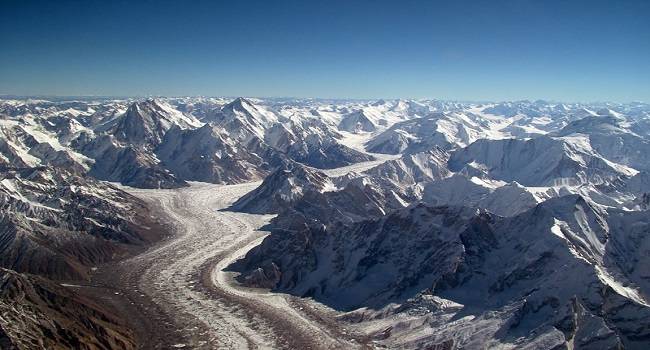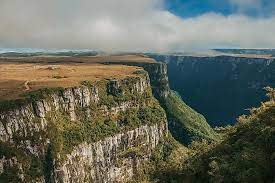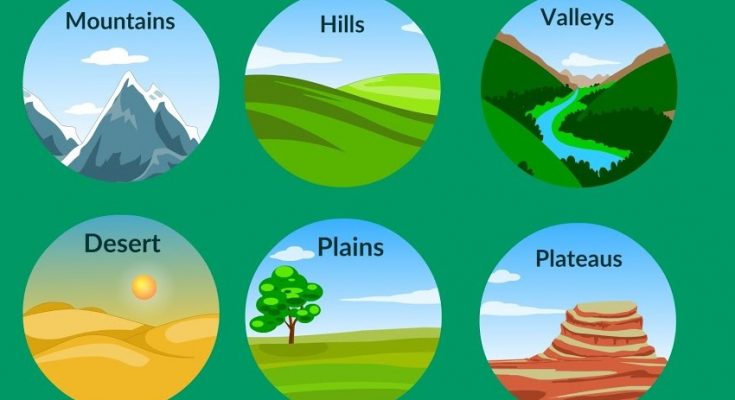Major Landforms of The Earth Class 6th – Notes
Land Forms of The Earth
Surface of the earth is not the same everywhere. Some parts of the lithosphere may be rugged or some flat. In the ground of the earth, a slow continuous movement is going on. This continuous movement results in the formation of different types of landforms.
How are Landforms Formed?
2 Important Processes for Landform Formation
The landforms are a result of two processes:
- Internal process
- External process
Internal process
Internal processes generate in the interior of the earth and cause change in the surface of the earth.The internal process leads to the upliftment and sinking of the earth’s surface at several places.
External process
The external process is the continuous wearing down and rebuilding of the land surface.These processes are generated by the external agents like-air and water and cause change in the surface of the earth.
Hill
Hill is a land surface higher than the surrounding area.
Mountain
A steep hill with an elevation of more than 600 meters is termed as a mountain.
Erosion And Deposition
The wearing away of the earth’s surface is called erosion in which the surface is being lowered, while the process of rebuilding is called deposition. These two processes are carried away by different agents, like- running water, ice and wind.
What are the major landforms of the earth?
3 Important Types of Landforms
On the basis of elevation and slope, the landforms can be grouped into
- Mountains
- Plateaus and
- Plains
Mountains

- A mountain is a natural elevation of the earth’s surface.
- Some mountains may have a small summit and a broad base and some are higher than clouds.
- Some mountains are also found under the sea.
Glaciers

The permanently frozen rivers of ice found in some mountains are called glaciers.
Range

- Sometimes mountains arrange in a line called range.
- Various mountain systems have a series of parallel ranges widening over hundreds of kilometers.
- The Alps, the Andes and the Himalayas are mountain ranges of Europe, South America and Asia, respectively. Mountains vary in their heights and shapes.
Types of Mountain
Mountains are of three types:
3 Types of Mountains
- Fold Mountain
- Block Mountain
- Volcanic Mountain
Fold Mountain

- Fold mountains are with rugged relief and high conical peaks. For example- Himalayan mountains and Alps
- Fold Mountains with rounded features and low elevation like-Ural mountains in Russia and the Appalachians in North America. They are very old, fold mountains.
- One of the world’s oldest fold mountain systems is the Aravali range in India.
- This range has considerably worn down due to the processes of erosion.
Block Mountain

- Block mountains are created when large areas are broken and displaced vertically.
- The uplifted blocks are termed as horsts and the lower blocks are called Graben.
- The Vosges mountain and Rhine valley in Europe are examples of block mountains.
Volcanic Mountain

- Volcanic mountains are formed by volcanic activities.
- They are formed by the deposition and solidification of lava.
- Mt. Kilimanjaro in Africa and Mt. Fujiyama in Japan are examples of such mountains.
4 Important Advantages of Mountain
The advantages of mountains are as follows:
- The river valleys and terraces are ideal for cultivation of crops. Mountains possess a rich variety of flora and fauna.
- Mountains have rich forest cover which provide fuel, fodder, shelter and other products like gum, raisins, etc.
- Mountains attract a number of tourists and hence promote tourism. They visit mountains for their scenic beauty.
- Various sports like paragliding, hand gliding, river rafting and skiing are popular in the mountains.
Plateaus

- A plateau is an elevated flat land.
- A plateau may have one or more sides with steep slopes.
- Plateau is a flat-topped table land standing above the surrounding area.
- The East African plateau in Kenya, Tanzania and Uganda and the Western plateau of Australia are other examples. Plateaus may be young or old, the Deccan plateau of India is one of the oldest plateaus.
- The height of plateaus varies from a few hundred meters to several thousand meters.
- The Tibet plateau is the highest plateau in the world with the height of 4,000 to 6,000 meters above mean sea level.
3 Important Advantages of Plateaus
The advantages of plateaus are as follows:
- Plateaus are very rich in mineral deposit, this is the reason behind the locations of many mining areas in plateau regions in the world. The African plateau is famous for gold and diamond mining while Chhotanagpur plateau in India is famous for the deposition of manganese, coal and iron.
- In the plateau regions, several waterfalls are found as many rivers in India fall from a great height. The Hundru falls in the Chhotanagpur plateau on the river Subarnarekha and the Jog falls in Karnataka are examples of such waterfalls.
- The lava plateaus are rich in black soil that are fertile and good for cultivation.
Plains

- Plains are large areas or stretches of flat land.
- Generally, they are with the height of not more than 200 meters above sea level
- Some plains are extremely level and some are with slightly rolling and undulating surfaces.
- Some of the largest plains made by the rivers are found in Asia and North America.
How Plains are formed?
Formation of Plains
- Most of the plains are formed by the deposition of rivers and their tributaries.
- The rivers flow down the slopes of mountains and erode them.
- They carry forward the eroded material. Then, they deposit their load consisting of stones, sand and silt along their courses and in their valleys. It is from these deposits that plains are formed.
Examples of Plains
In Asian continent, Plains are formed by the Ganga and Brahmaputra in India.
The Yangtze in China
4 Important Advantages of Plains
The advantages of plains are as follows:
- The plains are the most useful regions for human Habitation.
- Plains generally are very fertile for farming.
- The large flat areas are available for construction of houses, and productive for cultivation.
- The construction of a transport network is easy in these areas because of the plain surface.
Landforms and the People
Human beings are living on different kinds of landforms in different ways. Leading a life is much tougher in mountain regions than plains. We can easily grow crops, build houses or a road in the plains than the mountains. Sometimes, natural calamities like earthquakes, volcanic eruptions, storms and floods cause widespread destruction and huge loss of life and property. But through awareness programmes about such incidents we may lower the risks. Usually, we use the land in a wasteful manner, For example constructing houses on fertile land. Likewise we throw garbage on land or in water making them polluted.

3 Comments on “Major Landforms of The Earth Class 6th”